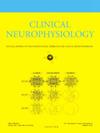药物诱发的帕金森病与帕金森病的低频脑电图功率和一致性存在差异
IF 3.7
3区 医学
Q1 CLINICAL NEUROLOGY
引用次数: 0
摘要
目的药物诱发帕金森病(DIP)是仅次于帕金森病(PD)的第二大帕金森病。尽管症状相似,但药物性帕金森综合征(DIP)是由接触特定药物或物质引起的,因此需要准确诊断。在此,我们使用静息状态脑电图(rsEEG)研究了DIP和PD的神经标记物特征。经过排除,我们分析了 15 名 DIP 患者、41 名 PD 患者和 12 名 HC 患者的数据。结果表明,DIP、PD 和 HC 组之间的 rsEEG 模式存在显著差异。与 PD 患者和 HC 相比,DIP 患者表现出更高的 Theta 波段功率。意义我们的研究结果表明,rsEEG有望成为捕捉DIP和PD患者不同特征的重要工具。本文章由计算机程序翻译,如有差异,请以英文原文为准。
Low-frequency EEG power and coherence differ between drug-induced parkinsonism and Parkinson’s disease
Objective
Drug-induced parkinsonism (DIP) ranks second to Parkinson’s disease (PD) in causing parkinsonism. Despite sharing similar symptoms, DIP results from exposure to specific medications or substances, underscoring the need for accurate diagnosis. Here, we used resting-state electroencephalography (rsEEG) to investigate neural markers characterizing DIP and PD.
Methods
We conducted a retrospective analysis of rsEEG recordings from 18 DIP patients, 43 de novo PD patients, and 12 healthy controls (HC). After exclusions, data from 15 DIP, 41 PD, and 12 HC participants were analyzed. EEG spectral power and inter-channel coherence were compared across the groups.
Results
Our results demonstrated significant differences in rsEEG patterns among DIP, PD, and HC groups. DIP patients exhibited increased theta band power compared with PD patients and HC. Moreover, DIP patients showed higher delta band coherence compared with PD patients.
Conclusion
The current study highlights the differences in EEG spectral power and inter-channel coherence between DIP and PD patients.
Significance
Our results suggest that rsEEG holds promise as a valuable tool for capturing differential characteristics between DIP and PD patients.
求助全文
通过发布文献求助,成功后即可免费获取论文全文。
去求助
来源期刊

Clinical Neurophysiology
医学-临床神经学
CiteScore
8.70
自引率
6.40%
发文量
932
审稿时长
59 days
期刊介绍:
As of January 1999, The journal Electroencephalography and Clinical Neurophysiology, and its two sections Electromyography and Motor Control and Evoked Potentials have amalgamated to become this journal - Clinical Neurophysiology.
Clinical Neurophysiology is the official journal of the International Federation of Clinical Neurophysiology, the Brazilian Society of Clinical Neurophysiology, the Czech Society of Clinical Neurophysiology, the Italian Clinical Neurophysiology Society and the International Society of Intraoperative Neurophysiology.The journal is dedicated to fostering research and disseminating information on all aspects of both normal and abnormal functioning of the nervous system. The key aim of the publication is to disseminate scholarly reports on the pathophysiology underlying diseases of the central and peripheral nervous system of human patients. Clinical trials that use neurophysiological measures to document change are encouraged, as are manuscripts reporting data on integrated neuroimaging of central nervous function including, but not limited to, functional MRI, MEG, EEG, PET and other neuroimaging modalities.
 求助内容:
求助内容: 应助结果提醒方式:
应助结果提醒方式:


